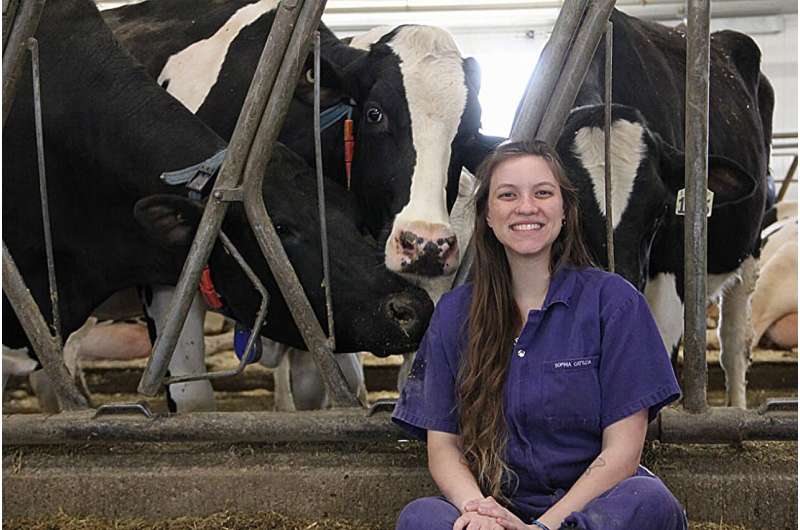This article has been reviewed according to Science X's editorial process and policies. Editors have highlighted the following attributes while ensuring the content's credibility:
fact-checked
trusted source
proofread
Precision nutrition for dairy cattle: Can robots help?

Feeding livestock today is not a matter of flinging some hay or silage in a stall and hoping for the best.
It's a carefully curated process to ensure the health of the animal, optimize production, and protect the environment.
Dairy cows present a unique feeding challenge. Increasingly, cows are milked by robots. But these robots are not simply milking machines; they also serve up what Sophia Cattleya Dondé describes as cow "dessert"—yummy nutrition-packed pellets.
"The robot is the full system," explained Dondé, a Ph.D. student in the College of Agriculture and Bioresources (AgBio) at USask. "It works 24/7. It's a voluntary system, so cows go voluntarily to the robot whenever they want to be milked.
"The pellet is one of the attractions. You give them pellets in the robot to make cows want to go to the robot more frequently."
But do the pellets actually influence milk production? Dondé decided to find out.
For cows milked in robot systems, the diet consists of the partial mixed ration (PMR), a high-quality forage-based component that cows consume in addition to the pellet. This means that pellet feeding might influence how much and when cows consume the PMR.
Specifically, Dondé researched whether pellet starch concentration, combined with the amount of pellet provided, affects the performance of lactating dairy cows and the nutrients they consume at all points of their production cycle.
Dondé noted that there is a gap in the literature on this subject, and it's important to fill it.
"We saw that people usually focus only on pellets and they don't realize that the feed in the bunk still has the majority of the nutrients for cows," she said.
"Most studies don't focus on PMR intake. They tend to focus on the amount of pellet located in the robot."
But when the amount of pellet in the robot is increased, she said the cows' PMR intake decreases. Here is where her human-to-cow dessert analogy comes in.
"You may not eat your full meal. Mmm, I'm not going to eat that much rice or vegetables ... because I really want that cake.
"You start to substitute your principal meal with dessert. It's almost what cows do. They don't eat everything out of the bunk that they're supposed to eat. They eat the pellet, so they substitute."
So does starch content of the pellet influence milk production?
The first part of her project was conducted last year under the supervision of Dr. Greg Penner (Ph.D.), Centennial Enhancement Chair in Ruminant Nutritional Physiology and professor in the College of AgBio.
In her study, Dondé used two concentrations of starch—24% and 34%—in the pellets. The lower starch concentration was based on the average used by Canadian dairy producers.
Dondé also varied the amount of pellet provided, giving some cows two kilograms a day and others six kilograms, regardless of their production levels.
The results? "Starch concentration had little effect on performance."
Not only that, but the cows generally did not consume all of their daily pellet allocations—with cows in the high-allocation treatment leaving an average of half a kilogram behind—while also not eating all of their PMR. Cows fed more pellet also ate less PMR and thereby altered nutrient supply.
This research showed that the pellet-feeding amount in the robot affects the ability to deliver a precision diet, while the pellet starch content had little effect. The next study will test whether protein influences cows' responses.
That will be the second leg of the investigation, which will be performed at the Rayner Dairy Research and Teaching Facility on the USask campus. The facility has 110 cows, of which Dondé will use about a quarter.
"We wanted to look at just starch, carbohydrate, first. We want to understand what the perfect pellet for cows would be and how they react based on what they're eating," Dondé said.
"We can collect all pellet that cows don't eat so we know exactly the amount of pellet that they ate for that milking visit, which is a unique feature in robotic milking research."
Robotic milking has changed the lives of dairy farmers. "Instead of having a fixed schedule of going there every morning and evening to milk a cow, it's a machine that operates by itself," Dondé said.
"Instead of the farmer having to be there for hours to milk the cows, they can manage their time differently."
This does not make the farmer less busy, she said. It just leaves time for other important farm management tasks.
"A lot of producers were saying the robot allowed them to have more quality time. They had more time to spend with family and more time to actually prepare themselves for the growing season or to make silage."
As for the cows, some studies have shown the robot can improve their health—reducing the frequency of mastitis, for example.
Dondé's ultimate goal is to support robotic milking by figuring out how to deliver the exact amount and profile of nutrients dairy cows need—for the benefit of both farmer and animal.
"If we can implement precision feeding ... we can save money, giving cows the amount of nutrients they will need."
It's good for the environment, as well. For example, less nitrogen is excreted by the animals if they are not being overfed with protein, Dondé noted.
"I really think it's important to understand what we're doing. How can we improve if we don't?"
Provided by University of Saskatchewan


















